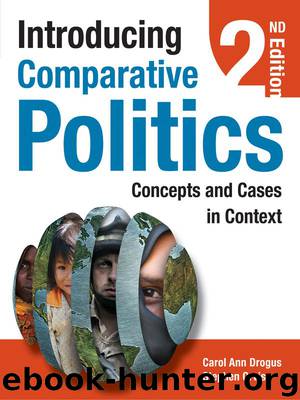Introducing Comparative Politics: Concepts and Cases in Context by Drogus Carol Ann & Orvis Stephen

Author:Drogus, Carol Ann & Orvis, Stephen [Drogus, Carol Ann]
Language: eng
Format: epub
ISBN: 9781483305127
Publisher: SAGE Publications
Published: 2011-07-21T00:00:00+00:00
CASE SUMMARY
Institutionalists would expect India’s FPTP electoral system to create a two-party system. In India, however, great social and cultural diversity, a federal system, and FPTP have combined to produce numerous state-level two-party systems (following Duverger’s Law). These forces have collectively created a multiparty national system, with two large national parties competing for power at the head of multiparty coalitions. Both institutional and sociological theories are essential to understand this evolution. Both major parties have lost support to the growing numbers of regional and state-level parties. In the 1977 election, the first one that Congress lost, the Congress and its primary national opponent together received 75 percent of the national vote. In the last three elections, the two major parties combined received less than half the total votes, and the myriad regional parties totaled about 29 percent (Hasan 2010, 245). This history is partly explained by the expansion of civil society, as excluded groups have organized and begun demanding greater access and participation. Unfortunately, some of these demands have taken violent forms, from some communist movements in the 1960s to the religious violence of the last decade. Much political organizing, however, has taken place within the nonviolent framework of India’s electoral system.
India provides a case study of an electoral system in a very different context from the wealthy, Western democracies. Combined with a federal system and ethnic and religious diversity, FPTP has followed Duverger’s Law, but only at the local level. As in the United States, federalism in India has helped decentralize the party system and has produced weak parties, while diversity has created many parties. A pluralist interest-group system also looks quite different in a country where the most important divisions are based not on industrialization but on region, ethnicity, caste, and religion. While often corrupt and sometimes violent, the Indian system has nonetheless persevered as a democratic system, keeping interest groups and parties mostly operating within institutionalized bounds. It has also been a system in which participation and representation have expanded over the decades.
Download
This site does not store any files on its server. We only index and link to content provided by other sites. Please contact the content providers to delete copyright contents if any and email us, we'll remove relevant links or contents immediately.
The Secret History by Donna Tartt(18843)
The Social Justice Warrior Handbook by Lisa De Pasquale(12141)
Thirteen Reasons Why by Jay Asher(8792)
This Is How You Lose Her by Junot Diaz(6793)
Weapons of Math Destruction by Cathy O'Neil(6142)
Zero to One by Peter Thiel(5685)
Beartown by Fredrik Backman(5594)
The Myth of the Strong Leader by Archie Brown(5424)
The Fire Next Time by James Baldwin(5248)
How Democracies Die by Steven Levitsky & Daniel Ziblatt(5127)
Promise Me, Dad by Joe Biden(5087)
Stone's Rules by Roger Stone(5026)
A Higher Loyalty: Truth, Lies, and Leadership by James Comey(4842)
100 Deadly Skills by Clint Emerson(4840)
Rise and Kill First by Ronen Bergman(4701)
Secrecy World by Jake Bernstein(4643)
The David Icke Guide to the Global Conspiracy (and how to end it) by David Icke(4624)
The Farm by Tom Rob Smith(4434)
The Doomsday Machine by Daniel Ellsberg(4415)
